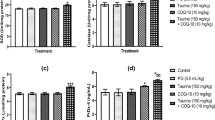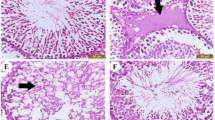Abstract
Single doses of procarbazine (MIH) were injected IP at 0, 50, 100, 200, and 400 mg/kg body weight to CD-1 male mice. Activities of hyaluronidase, lactate dehydrogenase isoenzyme-X, and the dehydrogenases of sorbitol, α-glycerophosphate, glucose-6-phosphate, malate, isocitrate, and glyceraldehyde-3-phosphate in the testes of the mice were determined and correlated with changes in spermatogenic cell types in seminiferous tubules. All enzyme activities were higher than controls or remained unchanged on days 10–20 after drug treatment. Activities of hyaluronidase, sorbitol dehydrogenase, and lactate dehydrogenase isoenzyme-X decreased significantly to below normal levels on day 30 after drug treatment for all doses, whereas those of the other five dehydrogenases remained significantly higher than controls. All enzyme activities approached control levels with the concomitant recovery of spermatogenesis by day 60 after drug treatment. Histological examination of seminiferous tubules revealed that premeiotic spermatocytes were significantly reduced on days 10–20 but reappeared on day 30 after MIH treatment (400 mg/kg). The postmeiotic spermatogenic cells were unaffected at the time of MIH treatment, but had disappeared completely on day 30 after drug treatment. MIH, at the highest dosage, selectively destroyed spermatogonia and premeiotic spermatocytes; however spermatozoa and elongated spermatides were unaffected. This study demonstrated that the cytotoxic effect of MIH on spermatogenesis could be evaluated via changes in testicular enzyme activities. The present studies demonstrated that hyaluronidase, sorbitol dehydrogenase, and lactate dehydrogenase isoenzyme-X could serve as useful biochemical markers for assessing testicular toxicity induced by drugs and chemicals.
Similar content being viewed by others
References
Baggiolini M, Bickel MH, Messiha FS (1965) Demethylation in vivo of natulan, a tumour-inhibiting methylhydrazine derivative. Experientia 21: 334–336
Berneis K, Kofler M, Bollag W, Kaiser A, Langemann A (1963) The degradation of deoxyribonucleic acid by new tumour-inhibiting compounds — The intermediate formation of hydrogen peroxide. Experientia 19: 132–133
Berneis K, Kofler M, Bollag W, Zeller P, Kaiser A, Langemann A (1963) Degradation of deoxyribonucleic acid by tumour-inhibiting compounds — intermediate formation of H202. Helv Chim Acta 46: 2157–2161
Bollag W, Theiss E (1964) Methylhydrazine derivatives. In: Plattner PA (ed) Proceedings of the International Symposium on Chemotherapy of Cancer. Elsevier, Amsterdam, pp 311–313
Clermont U, Mauger A (1974) Existence of a spermatogonial chalone in the rat testis. Cell Tiss Kinet 7: 165–172
Ezumi K, Nakao H, Hayashi T (1972) Toxicological studies on procarbazine hydrochloride, an antitumor agent: subacute oral toxicity in rats and mice. Oyo Yakuri 6: 365–369
Freireich EJ, Gehan EA, Rall DP, Schmidt LH, Skipper HE (1966) Quantitative comparison of toxicity of anticancer agents in mouse, cat, dog, monkey, and man. Cancer Chemother Rept 50: 219–224
Gale GR, Simpson JG, Smith AB (1967) Studies on the mode of action of N-isopropyl-a-(2-methylhydrazino)-P-toluamide. Cancer Res 27: 1186–1191
Gomes WR, Van Demark NL (1974) The male reproductive system. A Rev Physiol 36: 307–330
Hitzeman JW (1962) Development of enzyme activity in the Leydig cells of the mouse testis. Anat Rec 143: 351–361
IARC Monograph (1981) On the evaluation of the carcinogenic risk of chemicals humans. 26: 311–339
Koblet H, Diggelmann H (1968) Action of benzmethylzin (N-isopropyl-a-(2-methyl-hydrazino)-p-toluamidhydrochlorid, NatulanR, IMTH) on protein synthesis in the rat liver. Eur J Cancer Clin Oncol 4: 45–58
Kreis W, Burchenal JH, Hutchinson DJ (1968) Influence of a methylhydrazine derivative on the in vivo transmethylation of the S-methyl group of methionine onto purine and pyrimidine bases of RNA. Proc Am Assoc Cancer Res 9: 38
Kreis W, Piepho SB, Bernhard HV (1966) Studies on the metabolic fate of the C14-labeled methyl group of a methylhydrazine derivative in P815 mouse leukemia. Experientia 22: 431–433
Kreis W, Yen W (1965) An antineoplastic C14-labeled methylhydrazine derivative in P815 mouse leukemia. A metabolic study. Experientia 21: 284–286
Lee IP, Dixon RL (1972) Effects of procarbazine on spermatogenesis studied by velocity sedimentation cell separation technique and serial mating. J Pharmacol Exp Ther 181: 219–226
Lee IP, Dixon RL (1978) Mutagenicity, carcinogenicity and teratogeneicity of procarbazine. Mutat Res 55: 1–14
Lowry OH, Rosebrough NJ, Farr AL, Randall RJ (1951) Protein measurement with the folin phenol reagent. J Biol Chem 193: 265–275
McLachlan JA, Dixon RL (1973) Reduced fertility in female mice exposed prenatally to procarbazine. Fed Proc 32: 745
Meyhofer W (1973) Auswirkungen von Cytostatika auf die Spermiogenase. Andrologie 5: 107–108
Oakberg EF (1956) A description of spermatogenesis in the mouse and its use in analysis of the cycle of the seminiferous epithelium and germ cell renewal. Amer J Anat 99: 391–413
Oliverio VT, Denham C, DeVita VT, Kelly MG (1964) Some pharmacologic properties of a new antitumor agent N-isopropyl-a-(2-methylhydrazino)-p-toluamide, hydrochloride (NSC 77213). Cancer Chemother Rep 42: 1–7
Parvinen L (1979) Early effects of procarbazine (N-isopropyl-L-(2-methyl-hydrazino)-p-toluamide hydrochloride) on rat spermatogenesis. Pathol 30: 1–11
Reed DJ, Dost FN (1966) Methane and CO2 formation by rats during metabolism of a methylhydrazine (natulan). Proc Am Assoc Cancer Res 7: 57
Russell LD, Lee IP, Ettlin RA, Malone JP (1983) Morphological pattern of response after administration of procarbazine: Alteration of specific cell associations during the cycle of the seminiferous epithelium of the rat. Tissue Cell 15: 391–404
Rutishauser A, Bollag W (1967) Untersuchungen über den Wirkungsmechanismus von Procarbazine (Natulan). Experientia 23: 222–223
Sartorelli AC, Creasey WA (1969) Cancer chemotherapy. In: Elliott HW, Cutting WC, Dreisbarth RH (eds) Annual review of pharmacology. Annual Reviews, Palo Alto, California, pp 51–72
Sartorelli AC, Tsunamura S (1966) Studies on the biochemical mode of action of a cytotoxic methylhydrazine derivative, N-isopropyla-(2-methylhydrazino)-p-toluamide. Mol Pharmacol 2: 275–283
Shen R, Lee IP (1976) Developmental patterns of enzymes in mouse testis. J Reprod Fertil 48: 301–305
Sherins RJ, DeVita VT (1973) Effect of drug treatment for lymphoma on male reproductive capacity. Studies of men in remission after therapy. Ann Int Med 79: 216–220
Sieber SM, Correa P, Dalgard DW, Adamson RH (1978) Carcinogenic and other adverse effects of procarbazine nonhuman primates. Cancer Res 38: 2125–2134
Snedecor GW, Cochran WG (1967) Statistical methods. 6th edn. The Iowa State University Press, Ames, Iowa
Spivack SD (1974) Drugs 5 years later: procarbazine. Ann Int Med 81: 795–800
Van Thiel DH, Sherins RJ, Myers GH, Jr, DeVita VT, Jr (1972) Evidence for a specific seminiferous tubular factor affecting FSH in man. J Clin Invest 51: 1009–1019
Weitzel G, Schneider F, Fretzdorff AM (1964) Cytostatic effect of methyl hydrazines. Experientia 20: 38–39
Weitzel G, Schneider F, Kummer D, Ochs H (1968). Cytostatischer Wirkungsmechanismus von Natulan. Z Krebsforsch 70: 354–358
Author information
Authors and Affiliations
Rights and permissions
About this article
Cite this article
Shen, R.S., Lee, I.P. Selected testicular enzymes as biochemical markers for procarbazine-induced testicular toxicity. Arch Toxicol 55, 233–238 (1984). https://doi.org/10.1007/BF00341017
Received:
Accepted:
Issue Date:
DOI: https://doi.org/10.1007/BF00341017




